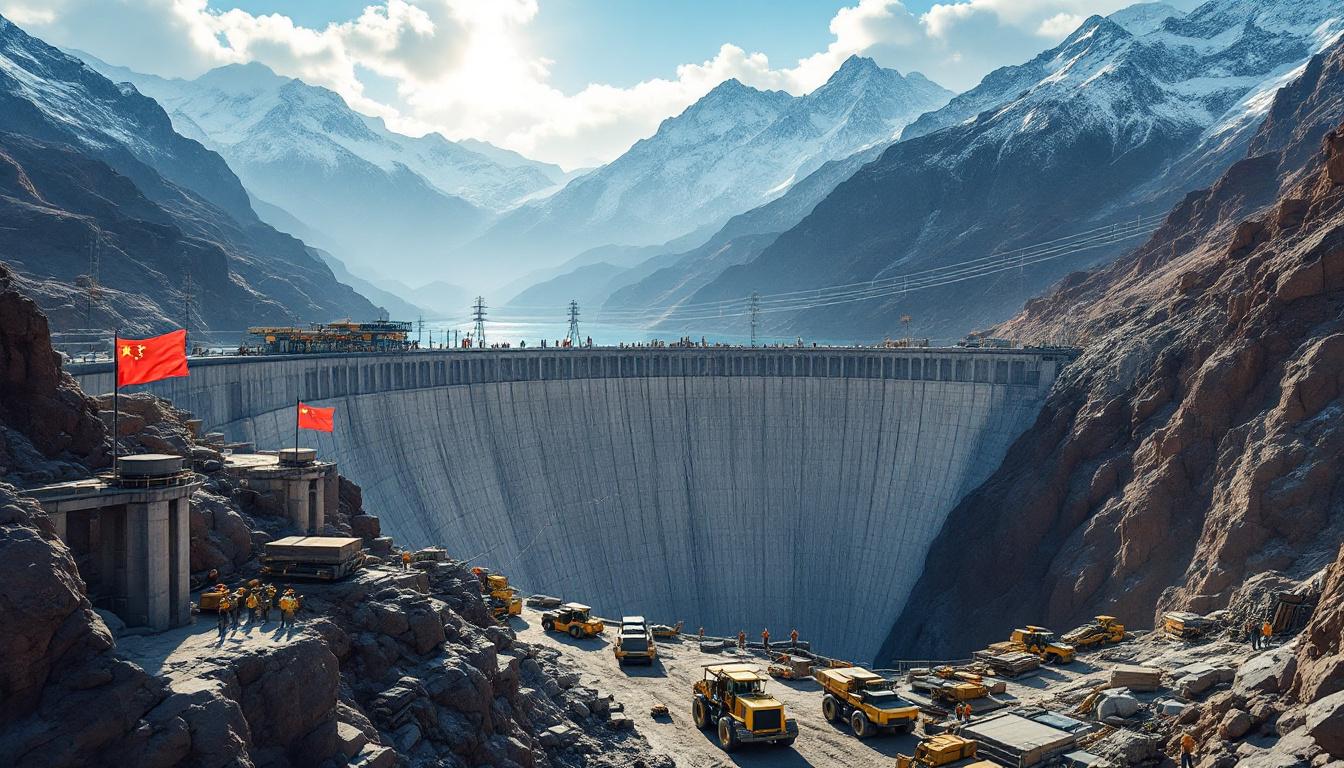What is the copper import dispute in India?
India's government is currently embroiled in a significant legal challenge from prominent metal trade associations regarding its copper import policy. The Bombay Metal Exchange and Bombay Non-Ferrous Metals Association filed a petition with the Bombay High Court in May 2025, contesting quality control measures implemented in December 2024. These trade bodies claim the restrictions could create a monopolistic market dominated by three domestic suppliers, potentially threatening copper supply for India's growing industrial sectors.
Government officials have taken a firm stance, pledging to "vigorously defend" their position against these claims. The dispute highlights the tension between India's strategic mineral security goals and the concerns of metal traders who rely on international supply chains.
"Where are the shortages? The only evidence they (trade bodies) have is that in December and January imports had reduced, which is old data," stated a government source familiar with the matter, emphasizing that companies had imported large quantities in October and November before the restrictions took effect.
Current legal challenge against copper import restrictions
The legal petition centers around quality control measures that require all copper cathode suppliers—both domestic and foreign—to obtain Bureau of Indian Standards (BIS) certification to sell in the Indian market. This certification process has created what trade associations describe as an artificial barrier that disproportionately affects foreign suppliers.
According to court documents, the trade associations argue that the certification requirements could severely restrict market access for international producers. They contend this would leave the market vulnerable to domination by a small group of domestic suppliers, potentially leading to higher prices and supply constraints for downstream industries that rely on copper inputs.
The government maintains that these concerns are unfounded, pointing to the already certified 15 suppliers (10 foreign and 5 domestic) as evidence that the market remains competitive and well-supplied.
Understanding India's copper import policy framework
The disputed quality control measures form part of India's broader critical minerals strategy established in 2023, which identified 30 minerals—including copper—as strategically important for the nation's economic security and industrial development.
Under the current certification system, there are 10 certified foreign copper suppliers (seven of which are Japanese) and five domestic certified suppliers. This certification process involves quality testing and compliance reviews to ensure all copper cathodes meet specific technical standards before entering the Indian market.
As the world's second-largest importer of refined copper, India's policy decisions carry significant weight in global metals markets. The country imports approximately 500,000 tons of refined copper annually, with Japan accounting for about two-thirds of this supply. Any shift in India's import policy has ripple effects throughout Asian copper supply chains.
The certification requirements align with India's broader "Atmanirbhar Bharat" (Self-Reliant India) initiative, which aims to reduce dependency on imports for strategically important resources while maintaining quality standards.
Why is India defending its copper import restrictions?
Indian government officials are standing firm on their copper import policy, arguing that the quality control measures serve legitimate national interests without causing market disruptions. This position reflects India's growing focus on resource security and domestic manufacturing capacity for critical minerals.
According to government representatives, the contested import restrictions are reasonable quality assurance measures rather than protectionist barriers. They maintain that similar standards apply to both foreign and domestic producers, creating a level playing field while ensuring quality control.
Government's position on domestic supply adequacy
Central to the government's defense is the assertion that there is sufficient domestic copper cathode supply with no shortages in the market. Officials contend that the reduced import volumes in December 2024 and January 2025—which trade associations cite as evidence of supply disruption—simply reflected earlier stockpiling by importers anticipating the new rules.
"Companies imported large quantities in October and November," noted a government source, explaining the subsequent drop in imports. The government has characterized the trade associations' concerns as based on "old data" that fails to account for this inventory buildup and the continuing certification of new suppliers.
Officials plan to demonstrate in court that the current roster of certified suppliers can adequately meet market demands. They point to ongoing certification applications being processed, which would further expand supply options for copper consumers in India.
The government also highlights the imminent addition of significant new domestic capacity through Adani Enterprises' $1.2 billion copper smelter, scheduled to begin operations in June 2025. This facility is expected to substantially reduce India's import dependence.
Strategic importance of copper to India's economy
Beyond immediate market concerns, the government's defense rests on copper's classification as a critical mineral essential to India's economic and defense priorities. India formally identified copper among 30 critical minerals in its 2023 strategic minerals assessment, recognizing its irreplaceable role in multiple strategic sectors.
Copper serves as a crucial input for India's rapidly expanding renewable energy sector, with solar and wind power installations requiring significant quantities of the metal. The automotive industry—especially the growing electric vehicle segment—depends heavily on copper for motors, batteries, and charging infrastructure. Defense applications and infrastructure development also drive substantial copper demand.
Government officials view domestic production capacity as a matter of strategic resource security, particularly as global competition for critical minerals intensifies. The policy aligns with India's broader self-sufficiency goals in strategic supply chains, aiming to reduce vulnerability to international market disruptions or geopolitical tensions that could affect copper availability.
This approach mirrors similar resource security policies implemented by other major economies, including China's management of rare earth supplies and Indonesia's restrictions on nickel exports, reflecting a global trend toward greater state involvement in critical mineral supply chains.
How does India's copper market currently function?
India's copper market operates at the intersection of robust domestic demand and significant import dependence. The country's consumption patterns reflect its industrial growth trajectory, with manufacturing, construction, electrical, and renewable energy sectors driving increasing demand.
The market encompasses primary producers with smelting and refining capacity, downstream fabricators converting refined copper into wires, tubes, and components, and a wide range of end-users across various industries. International trade plays a crucial role in balancing supply and demand.
Current production capacity and import dependence
India's refined copper production currently stands at approximately 555,000 tons annually, falling well short of domestic demand. To address this gap, the country imports around 500,000 tons of copper yearly, making it the world's second-largest importer of refined copper.
Japan dominates India's copper import landscape, accounting for approximately two-thirds of total refined copper imports. This relationship has developed due to Japan's reputation for high-quality production and established trade relationships. Tanzania and Mozambique represent the next largest sources of copper imports to India, though at significantly smaller volumes.
The market structure includes several key domestic players:
- Hindalco Industries: A major integrated copper producer with mining, smelting, and downstream operations
- Vedanta: Operates copper smelting facilities (though facing challenges with its Sterlite plant)
- Hindustan Copper: The state-owned enterprise engaged in mining and processing
- Adani Enterprises: Emerging player with its upcoming smelter project
Despite this domestic capacity, India's copper cathode supply remains heavily reliant on imports—a situation that has driven both the government's strategic concerns and the current policy dispute.
Impact of historical production disruptions
India's current import dependence was significantly exacerbated by the 2018 closure of Vedanta's Sterlite copper smelter in Thoothukudi, Tamil Nadu. This facility, with an annual capacity of approximately 400,000 tons, represented a substantial portion of India's domestic production capability.
Following environmental concerns and public protests, state authorities ordered the permanent closure of the plant. This sudden removal of production capacity created a significant gap in domestic supply that had to be filled by imports, transforming India from a net exporter to a net importer of refined copper virtually overnight.
Copper imports surged in the aftermath of this closure, creating new trade patterns and supply chain dependencies that continue to shape the market today. The industrial sectors that previously relied on domestic copper had to rapidly adapt to international sourcing, often at higher costs due to import duties and logistics expenses.
This historical context is crucial for understanding the current tensions between import liberalization and domestic production promotion. The market has been adapting to this supply chain reconfiguration for several years, with both importers and domestic producers adjusting their strategies accordingly.
What changes are expected in India's copper supply chain?
India's copper supply landscape is poised for significant transformation in the coming years, with new domestic production capacity, evolving regulatory frameworks, and changing demand patterns reshaping the market. These changes will influence not only domestic price dynamics but also India's position in global copper trade.
Industry analysts project substantial shifts in the balance between imports and domestic production, potentially reversing the import dependence that has characterized the market since 2018.
Adani's emerging role in domestic copper production
The most immediate and significant change on the horizon is Adani Enterprises' new copper smelter, expected to become operational by June 2025. This $1.2 billion facility represents a major addition to India's production capacity and a cornerstone of the government's strategy to reduce copper imports.
Government sources have stated that the facility "will fulfill India's domestic requirements," suggesting it has sufficient capacity to substantially close the current supply gap. While specific production capacity figures haven't been publicly disclosed, the facility is expected to be among the largest in India.
The smelter incorporates modern technology aimed at both efficiency and environmental compliance—critical factors given the environmental challenges that led to the closure of Vedanta's Sterlite facility. Adani has positioned the project as aligned with both sustainability goals and India's self-sufficiency strategy.
This facility will likely shift market dynamics by introducing substantial new domestic supply, potentially reducing dependence on Japanese imports and providing downstream industries with more locally-sourced options. The timing of this production addition coincides with the government's policy push for domestic sourcing of critical minerals.
Projected growth in copper demand
While supply adjustments are underway, India's copper demand is projected to double by 2030 from current levels. This growth trajectory is driven by several factors:
- Renewable energy expansion: India's ambitious solar and wind power targets require significant copper inputs for generation equipment, transformers, and transmission infrastructure
- Electric vehicle manufacturing: The government's push for electric mobility will drive demand for copper in batteries, motors, and charging systems
- Infrastructure development: Ongoing and planned construction projects, including smart cities and transportation networks, require substantial copper inputs
- Defense manufacturing: India's growing defense industrial base utilizes copper in various applications
- Electronics manufacturing: Expansion of domestic electronics production creates additional copper demand
This projected demand growth presents both challenges and opportunities for India's copper industry. Domestic companies including Hindalco Industries, Vedanta, Adani, and state-owned Hindustan Copper are positioning themselves to capture this growth through capacity expansions and vertical integration.
The supply chain reconfiguration currently underway aims to position domestic producers to meet this growing demand, supported by policy frameworks that encourage local sourcing. However, even with expanded domestic capacity, India may continue to require imports for specific grades or during demand surges.
What are the broader implications of India's copper policies?
India's approach to copper supply chain management carries implications that extend well beyond immediate market dynamics. The policies reflect broader economic and geopolitical considerations, including international trade relationships, resource security strategies, and industrial development priorities.
The ongoing legal dispute highlights fundamental tensions between different visions of India's economic development—one emphasizing openness to global trade and another prioritizing self-sufficiency in strategic sectors.
Trade relationship impacts and international considerations
India's copper quality control measures most directly affect Japan, which currently supplies approximately two-thirds of India's copper imports. Japanese producers face new compliance hurdles that could potentially reduce their market access, though seven Japanese companies have already obtained the necessary certification.
The certification requirements create additional compliance costs and administrative processes for international suppliers seeking to maintain access to India's substantial copper market. These hurdles, while not insurmountable, change the competitive landscape between domestic and foreign suppliers.
India's measures represent part of a broader resource nationalism approach that has gained traction globally. Similar to Indonesia's restrictions on nickel exports and China's management of rare earth elements, India's policies reflect a growing tendency among resource-rich or resource-dependent countries to exercise greater control over critical mineral supply chains.
These policies have potential to reshape regional copper trade flows and pricing. If India successfully reduces import dependence, traditional suppliers like Japan may need to redirect exports to other markets, potentially affecting regional copper price insights and trade patterns throughout Asia.
The approach could also face challenges under international trade agreements. While quality control measures are generally permitted under World Trade Organization rules, trading partners might question whether India's implementation creates unnecessary trade barriers or discriminates against foreign suppliers.
Balance between self-sufficiency and import needs
The government faces a delicate balancing act between protecting and developing domestic industry while ensuring adequate supply for copper-consuming sectors. Too restrictive an approach could lead to supply shortages or price increases that harm downstream industries; too open an approach might undermine copper investment trends.
The certification system attempts to thread this needle by maintaining quality standards while creating an environment favorable to domestic production expansion. By applying the same standards to all suppliers while simultaneously supporting domestic capacity additions, the government aims to gradually shift the supply mix without disrupting the market.
This approach reflects India's broader economic strategy of selective protectionism in areas deemed strategically important, combined with continued engagement in global trade. Similar approaches have been applied to sectors like electronics manufacturing, pharmaceuticals, and defense production.
The legal challenge by metal trade associations highlights tensions between trade liberalization and resource security goals. This dispute will likely establish important precedents for how India manages critical mineral supply chains going forward, potentially affecting policies for other minerals beyond copper.
Industry stakeholders across the copper value chain are closely monitoring this case for indications of India's longer-term approach to balancing domestic industry protection with integration into global supply networks.
FAQs about India's copper import restrictions
What sparked the legal challenge against India's copper import restrictions?
The Bombay Metal Exchange and Bombay Non-Ferrous Metals Association filed a petition with the Bombay High Court in May 2025, challenging quality control measures implemented by the Indian government in December 2024. Their central claim is that these restrictions could create a monopolistic market dominated by three domestic suppliers, potentially leading to supply shortages and price increases for copper-consuming industries.
The trade associations argue that the certification requirements create unnecessary barriers that disproportionately affect foreign suppliers, despite government assertions that both domestic and foreign companies must meet the same standards. This legal challenge represents the formalization of concerns that had been building in the trading community since the measures were first announced.
How significant is copper to India's economy?
Copper plays a critical role in India's economic development as one of 30 minerals officially classified as "critical" in the government's 2023 strategic assessment. This metal serves as an essential input across numerous high-priority sectors:
- Energy infrastructure: Copper is vital for power generation, transmission, and distribution systems
- Renewable energy: Solar panels, wind turbines, and energy storage systems require substantial copper inputs
- Transportation: Vehicles, particularly electric models, use significant amounts of copper in components and charging systems
- Electronics: Circuit boards, semiconductors, and communication devices depend on copper's electrical conductivity
- Defense applications: Military systems utilize copper in various applications from ammunition to electronics
- Construction: Building infrastructure requires copper for electrical wiring, plumbing, and structural components
With demand projected to double by 2030, copper's importance to India's industrial growth and energy transition plans continues to increase. This strategic significance underpins the government's interest in securing reliable domestic supply chains for the metal.
What is the current balance between domestic production and imports in India's copper market?
India currently produces approximately 555,000 tons of refined copper annually while importing around 500,000 tons to meet domestic demand. This near-even split between domestic production and imports represents a significant shift from India's position prior to 2018, when the country was a net exporter of refined copper.
The balance shifted dramatically after the 2018 closure of Vedanta's Sterlite copper smelter in Tamil Nadu, which had an annual capacity of approximately 400,000 tons. This sudden removal of domestic capacity created a substantial supply gap that necessitated increased imports, primarily from Japan.
This import dependence has created vulnerabilities in India's copper supply chain, including exposure to international price fluctuations, currency exchange risks, and potential US tariff copper impact. The government's current policy approach aims to gradually rebalance this equation in favor of domestic production.
How might Adani's new copper smelter affect India's import policies?
The government has stated that Adani Enterprises' new $1.2 billion copper smelter, expected to become operational by June 2025, will "fulfill India's domestic requirements" and significantly reduce the need for imports. This facility represents a cornerstone of India's strategy to achieve greater self-sufficiency in copper production.
While specific production capacity figures haven't been publicly disclosed, the facility is positioned to substantially narrow the gap between domestic supply and demand. This added capacity could potentially allow the government to take a more assertive approach to import management, knowing that domestic supply options have expanded.
The smelter's impact will likely extend beyond direct production numbers. Its operational efficiency, production costs, and ability to meet quality standards will influence the competitive landscape between domestic production and imports. If the facility achieves cost-effective production while meeting [quality requirements](https://economictimes.indiatimes.com/news/economy/foreign-trade/india-to-defend-import-curbs-on-copper-in-legal-tussle-with-trade-associations-sources-say/articleshow/121135660.
Want to Identify the Next Major Mineral Discovery Before the Market?
Stay ahead of copper market movements and discover potential investment opportunities with Discovery Alert's proprietary Discovery IQ model. Receive real-time alerts on significant ASX mineral discoveries, transforming complex data into actionable insights for your investment strategy. Visit our discoveries page to see how major mineral discoveries have generated substantial returns for early investors.




